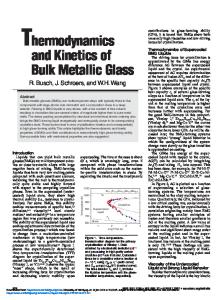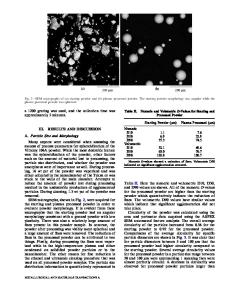Stress-assisted-electrochemical corrosion of Cu-based bulk metallic glass
- PDF / 1,023,230 Bytes
- 6 Pages / 584.957 x 782.986 pts Page_size
- 6 Downloads / 348 Views
Mimi Yang MSTC Program, Paul Laurence Dunbar High School, Lexington, Kentucky 40513
Fuqian Yanga) Materials Program, Department of Chemical and Materials Engineering, University of Kentucky, Lexington, Kentucky 40506
Peter K. Liaw Department of Materials Science and Engineering, University of Tennessee, Knoxville, Tennessee 37994 (Received 15 October 2009; accepted 7 December 2009)
Using the microindentation test, the stress-assisted-electrochemical corrosion of Cu46.25Zr45.25Al7.5Er1 bulk metallic glass (BMG) was studied in a 10 wt% NaCl electrolyte. The microindentation was performed in an indentation load range of 500 to 4000 mN to create shear bands over the deformation zone. Electric current of various densities was passed through the indented BMGs to evaluate the effect of shear bands and localized deformation on the electrochemical corrosion of the BMGs. Surface pits always initiated from the shear-banding zone and the contact edges between the indenter and the BMGs, and the size of the corroded zone grew with the increase in the polarization time, the indentation load, and the current density. Wormlike amorphous whiskers were formed over the corroded zone, and the density of the wormlike whiskers increased with the current density and polarization time.
I. INTRODUCTION
The development in the fabrication of bulk metallic glasses (BMGs) has led to the discovery of BMGs in a variety of systems, including the Pd-, Pt-, Au-, Mg-, Zr-, Ti-, Hf-, La-, Cu-, Fe-, Co, Y-, and Ni-based systems. BMGs are characterized by the lack of crystallographic slip planes and plastically deformed through the formation of highly localized shear bands. These shear bands are sensitive and weak locations for metallic glasses, which likely will be the active sites for fast material dissolution because of the interaction between mechanical stress and corrosive action, leading to the formation and growth of surface pitting. To understand structural integrity of BMGs for practical applications in various environmental conditions, the corrosion behavior of several metallic glass systems has been studied under the action of mechanical stresses.1–4 Recently, Jiang et al.5 used a cyclic anodic polarization technique to investigate the corrosion behaviors of the as-cast, deformed, and relaxed Zr-based BMGs and related the corrosion behaviors to the amount of free volume. However, most of these reports had focused on the stress-corrosion cracking of BMGs, and a)
Address all correspondence to this author. e-mail: [email protected] DOI: 10.1557/JMR.2010.0062
592
http://journals.cambridge.org
J. Mater. Res., Vol. 25, No. 3, Mar 2010 Downloaded: 16 Mar 2015
there are few studies addressing the effect of localized deformation on the corrosion behavior of BMGs. BMGs with high hardness and the absence of grain boundaries and second phases are attractive for structural applications involving surface contact. The surface contact can cause the breakdown and reformation of passive film and result in surface pitting and stress-corrosion cracki
Data Loading...











